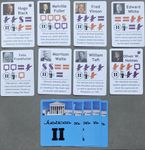


|
|
|
|
2-4
90'
14
No necessary in-game text
|
First Monday in October
 The game can be ordered, but we do not have any information about it.
The game can be ordered, but we do not have any information about it.
On the first Monday in October, the all-powerful Justices of the U.S. Supreme Court gather each year in their "marble palace" to decide the fate of the free world. Each player represents a long-standing institute, association, or think tank attempting to gain renown by shaping the composition of the high court, taking sides in landmark cases throughout the history of the United States, and determining the governing laws of the land. Players need to use their limited influence and actions wisely to control the judicial philosophy of the court and to prevail in as many cases as possible. Over the course of two hours, First Monday in October — for which designer Jason Matthews was the lead developer — re-creates the history of the U.S. Supreme Court from 1789 to the present day, through three distinct eras: Era I represents the founding of the Court in 1789 until the Civil War in 1865; Era II represents 1866 until the seminal decision of Brown v. Board in 1954; and Era III represents 1955 until the present day. The game revolves around the following four judicial philosophy tracks: Commerce Clause: This track represents the scope of Article I, Section 8 of the U.S. Constitution, which grants Congress the power to "regulate commerce" among the several states. Equality & Liberty: This track broadly represents the scope of individual equality and liberty, including but not limited to the 14th Amendment (i.e., equal protection, due process, and privacy rights). Free Speech: This track represents the obligation in the 1st Amendment that Congress make no law abridging a person's freedom of speech, and the scope of permissible restrictions on that freedom. Executive Power: This track broadly represents the scope of Article II of the U.S. Constitution, which enumerates the powers of the executive branch, including the Office of the President and law enforcement. Shifting each philosophy one way generally represents a more expansive centralized Federalist interpretation of these constitutional provisions (consistent with a Hamilton-Madison perspective), whereas shifting each philosophy the other direction represents a more narrow decentralized Anti-Federalist application of these provisions (consistent with a Jefferson-Monroe perspective). —description from the publisher
| Mechanics: | |
| Categories: | Political/Negotiation |
| Alternative names: | |
| This was seen 370 times | |
On the first Monday in October, the all-powerful Justices of the U.S. Supreme Court gather each year in their "marble palace" to decide the fate of the free world. Each player represents a long-standing institute, association, or think tank attempting to gain renown by shaping the composition of the high court, taking sides in landmark cases throughout the history of the United States, and determining the governing laws of the land. Players need to use their limited influence and actions wisely to control the judicial philosophy of the court and to prevail in as many cases as possible. Over the course of two hours, First Monday in October — for which designer Jason Matthews was the lead developer — re-creates the history of the U.S. Supreme Court from 1789 to the present day, through three distinct eras: Era I represents the founding of the Court in 1789 until the Civil War in 1865; Era II represents 1866 until the seminal decision of Brown v. Board in 1954; and Era III represents 1955 until the present day. The game revolves around the following four judicial philosophy tracks: Commerce Clause: This track represents the scope of Article I, Section 8 of the U.S. Constitution, which grants Congress the power to "regulate commerce" among the several states. Equality & Liberty: This track broadly represents the scope of individual equality and liberty, including but not limited to the 14th Amendment (i.e., equal protection, due process, and privacy rights). Free Speech: This track represents the obligation in the 1st Amendment that Congress make no law abridging a person's freedom of speech, and the scope of permissible restrictions on that freedom. Executive Power: This track broadly represents the scope of Article II of the U.S. Constitution, which enumerates the powers of the executive branch, including the Office of the President and law enforcement. Shifting each philosophy one way generally represents a more expansive centralized Federalist interpretation of these constitutional provisions (consistent with a Hamilton-Madison perspective), whereas shifting each philosophy the other direction represents a more narrow decentralized Anti-Federalist application of these provisions (consistent with a Jefferson-Monroe perspective). —description from the publisher
| Mechanics: | |
| Categories: | Political/Negotiation |
| Alternative names: | |
| This was seen 370 times | |
















































